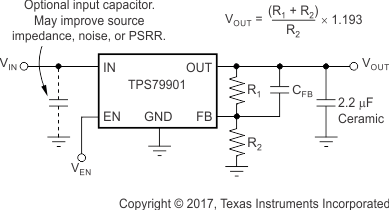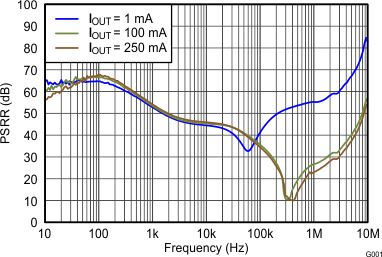ZHCSGP9A September 2017 – October 2017 TPS79901-EP
PRODUCTION DATA.
8 Application and Implementation
NOTE
Information in the following applications sections is not part of the TI component specification, and TI does not warrant its accuracy or completeness. TI’s customers are responsible for determining suitability of components for their purposes. Customers should validate and test their design implementation to confirm system functionality.
8.1 Application Information
The TPS79901 LDO regulator provides high PSRR while maintaining ultra-low-current consumption. The device also features inrush current protection and overshoot detection at the output.
8.2 Typical Applications
Figure 28 shows the basic circuit connections.
 Figure 28. Typical Application Circuit for Adjustable Voltage Version
Figure 28. Typical Application Circuit for Adjustable Voltage Version
8.2.1 Design Requirements
Select the desired device based on the output voltage.
Provide an input supply with adequate headroom to account for dropout and output current to account for the GND terminal current, and power the load.
8.2.2 Detailed Design Procedure
8.2.2.1 Input and Output Capacitor Requirements
Although an input capacitor is not required for stability, good analog design practice is to connect a 0.1-μF to
1-μF low ESR capacitor across the input supply near the regulator. This capacitor counteracts reactive input sources and improves transient response, noise rejection, and ripple rejection. A higher-value capacitor may be necessary if large, fast rise-time load transients are anticipated, or if the device is located several inches from the power source. If source impedance is not sufficiently low, a 0.1-μF input capacitor may be necessary to ensure stability.
The TPS79901 is designed to be stable with standard ceramic capacitors with values of 2.2 μF or greater. X5R- and X7R-type capacitors are best because they have minimal variation in value and ESR over temperature. Maximum ESR must be less than 1 Ω.
8.2.2.2 Output Noise
In most LDOs, the band gap is the dominant noise source. If a noise-reduction capacitor (CNR) is used with the TPS79901, the band gap does not contribute significantly to noise. Instead, noise is dominated by the output resistor divider and the error amplifier input. To minimize noise in a given application, use a 0.01-μF noise reduction capacitor. To further optimize noise, equivalent series resistance of the output capacitor can be set to approximately 0.2 Ω. This configuration maximizes phase margin in the control loop, reducing total output noise by up to 10%.
Noise can be referred to the feedback point; with CNR = 0.01 μF total noise is approximately given by Equation 1:

8.2.2.3 Dropout Voltage
The TPS79901 uses a PMOS pass transistor to achieve a low-dropout voltage. When (VIN – VOUT) is less than the dropout voltage (VDO), the PMOS pass device is in its linear region of operation and rDS(on) of the PMOS pass element is the input-to-output resistance. Because the PMOS device behaves like a resistor in dropout, VDO approximately scales with the output current.
As with any linear regulator, PSRR degrades as (VIN – VOUT) approaches dropout. This effect is illustrated in Figure 11 through Figure 19 in the Typical Characteristics section.
8.2.2.4 Transient Response
As with any regulator, increasing the size of the output capacitor reduces over- and undershoot magnitude, but increases the duration of the transient response. The transient response of the TPS799 is enhanced by an active pulldown device that engages when the output overshoots by approximately 5% or more when the device is enabled. When enabled, the pulldown device behaves like a 350-Ω resistor to ground.
8.2.2.5 Minimum Load
The TPS79901 is stable with no output load. To meet the specified accuracy, a minimum load of 500 μA is required. With loads less than 500 μA at junction temperatures near 125°C, the output can drift up enough to cause the output pulldown device to turn on. The output pulldown device limits voltage drift to 5% typically; however, ground current can increase by approximately 50 μA. In typical applications, the junction cannot reach high temperatures at light loads because there is no noticeable dissipated power. The specified ground current is then valid at no load in most applications.
8.2.2.6 Feedback Capacitor Requirements
The feedback capacitor, CFB, shown in Figure 28 is required for stability. For a parallel combination of R1 and R2 equal to 250 kΩ, any value from 3 pF to 1 nF can be used. Values below 5 pF should be used to ensure fast startup; values above 47 pF can be used to implement an output voltage soft-start. Larger value capacitors also improve noise slightly. The TPS79901 is stable in unity-gain configuration (OUT tied to FB) without CFB.
8.2.3 Application Curve

| COUT = 2.2 µF | CNR = 0.01 µF |
8.3 Do's and Don'ts
Do place at least one 2.2-µF ceramic capacitor as close as possible to the OUT pin of the regulator.
Do not place the output capacitor more than 10 mm away from the regulator.
Do connect a 0.1-μF to 1-μF low equivalent series resistance (ESR) capacitor across the IN pin and GND input of the regulator.
Do not exceed the absolute maximum ratings.